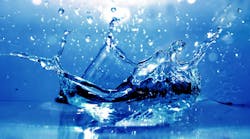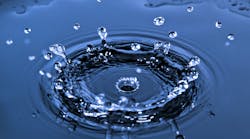By Patrick Crow, Washington Correspondent
Sharp budget cuts have been proposed for federal water programs, prompting water associations to prepare to lobby Congress again for funding.
President Barack Obama has proposed a $3.72 trillion budget for fiscal 2012, including slashes in water infrastructure spending at the Environmental Protection Agency (EPA) and the U.S. Army Corps of Engineers. Behind the cuts was the administration's goal to freeze non-security discretionary spending and halve the federal budget deficit in two years.
Congress, which has the ultimate power to set the federal budget, will draft a budget during the next few months - hopefully before fiscal 2012 begins Oct. 1.
Under the administration's proposal, the Drinking Water State Revolving Fund (SRF) would get $990 million in fiscal 2012, down from $1.387 billion in 2010. The Clean Water SRF would get $1.55 billion, down from $2.1 billion in 2010. The plan also would have states use 10% of their Drinking Water SRF funding and 20% of the Clean Water money for "green infrastructure" projects.
The administration also asked Congress to drop $157 million of water infrastructure "earmarks," since congressional leaders have pledged to avoid special spending requests in fiscal 2012.
EPA Administrator Lisa Jackson said President Obama's proposal would return the SRF programs to a "sustainable level" after they had received funding increases and economic stimulus boosts in fiscal 2010.
Overall, the administration requested $8.973 billion for EPA, down 13% from the fiscal 2010 budget of $10.3 billion. It would slash Corps of Engineers funding $913 million to $4.609 billion by reducing some water infrastructure programs and all Corps funding for local water and wastewater treatment projects.
The National Association of Clean Water Agencies (NACWA) said, "Budget cuts of any kind at this time to the Clean Water Act (CWA) program ignore the very real financial constraints of states and municipalities to implement a growing array of increasingly costly CWA requirements. While NACWA recognizes the austere budgetary times under which the federal government must operate, these same circumstances are being experienced in municipalities and rate-paying households across the country."
The association noted that EPA, the Government Accountability Office, and the Water Infrastructure Network have estimated the nation faces a $500 billion funding shortfall for water infrastructure over the next two decades.
Near term funding for the SRFs also was under pressure. Congress was debating terms of the continuing resolution (CR), which would set spending for the rest of fiscal 2011.
In its CR, the Republican-controlled House of Representatives planned to slash the Drinking Water SRF $557 million to $830 million. The Clean Water SRF by would be cut $1.3 billion to $800 million. Leaders of the Democratic-controlled Senate were not expected to approve such deep cuts.
USGS Great Lakes Report
The U.S. Geological Survey has warned that local shortages of water are possible in the states bordering the Great Lakes.
USGS said although groundwater pumping has had relatively little effect on water in the basin as a whole, pumping in the Chicago and Milwaukee areas has caused local groundwater levels to decline as much as 1,000 feet. It said if pumping increases as much as anticipated, water levels in these areas are estimated to decline an additional 100 feet by 2040.
Howard Reeves, a USGS scientist, said, "In some areas, the physical quantity of water may be limiting, and water availability in most of the Great Lakes Basin will be determined by social decisions about impacts of new uses on existing users and the environment."
He said, "The Great Lakes are a dynamic system responding primarily to short- and long-term variations in climate. Understanding the potential for local shortages or conflicts within this dynamic system is important for sound decision making."
The methodology that USGS developed for the Great Lakes study will be adapted to future study areas in the Colorado, the Delaware, and the Apalachicola-Chattahoochee-Flint River basins.
Cyndi Roper, the Michigan director of Clean Water Action, said, "While conservation and efficient water use should remain a top priority for the Great Lakes region and the municipalities drawing on the Great Lakes water supply, the report made clear that water withdrawals aren't the biggest threat facing the Great Lakes.
"With less ice cover to melt and replenish the water supply, and more frequent drought conditions upping the demand for water, the real threat to our Great Lakes is climate disruption."
In other Washington news;
--EPA has issued new source performance standards and emission guidelines for sewage sludge incineration units (SSIs) at wastewater treatment facilities. It said more than 150 of the 200 SSIs across the nation already are in compliance.
--The National Forest Service has proposed a broad revision of its 30-year-old land management planning process for national forests and grasslands. The agency said its lands include aquifers, streams and lakes that collectively are the largest source of drinking water in the nation.
--EPA has ordered Doña Ana County, N.M., and the City of Las Cruces to clean a contaminated aquifer under the city. The aquifer contains perchloroethylene, widely used for dry cleaning and degreasing, above the maximum level allowed by the Safe Drinking Water Act.
--The National Rural Water Association said the Central Iowa Water Association in Newton, Iowa, has won its 2011 award for the best tasting water in the nation. Pocomoke City, Md., won second place and the McNulty Water system of Saint Helens, Ore. won third.
-- EPA has awarded $868,000 to Clinton, Iowa, for wastewater system improvements. The $3.9 million project is due completion in the spring of 2012. The work includes a lift station and 17,200 feet of pipe to move wastewater from Low Moor, Iowa, to a treatment plant.
WW
More WaterWorld Current Issue Articles
More WaterWorld Archives Issue Articles


